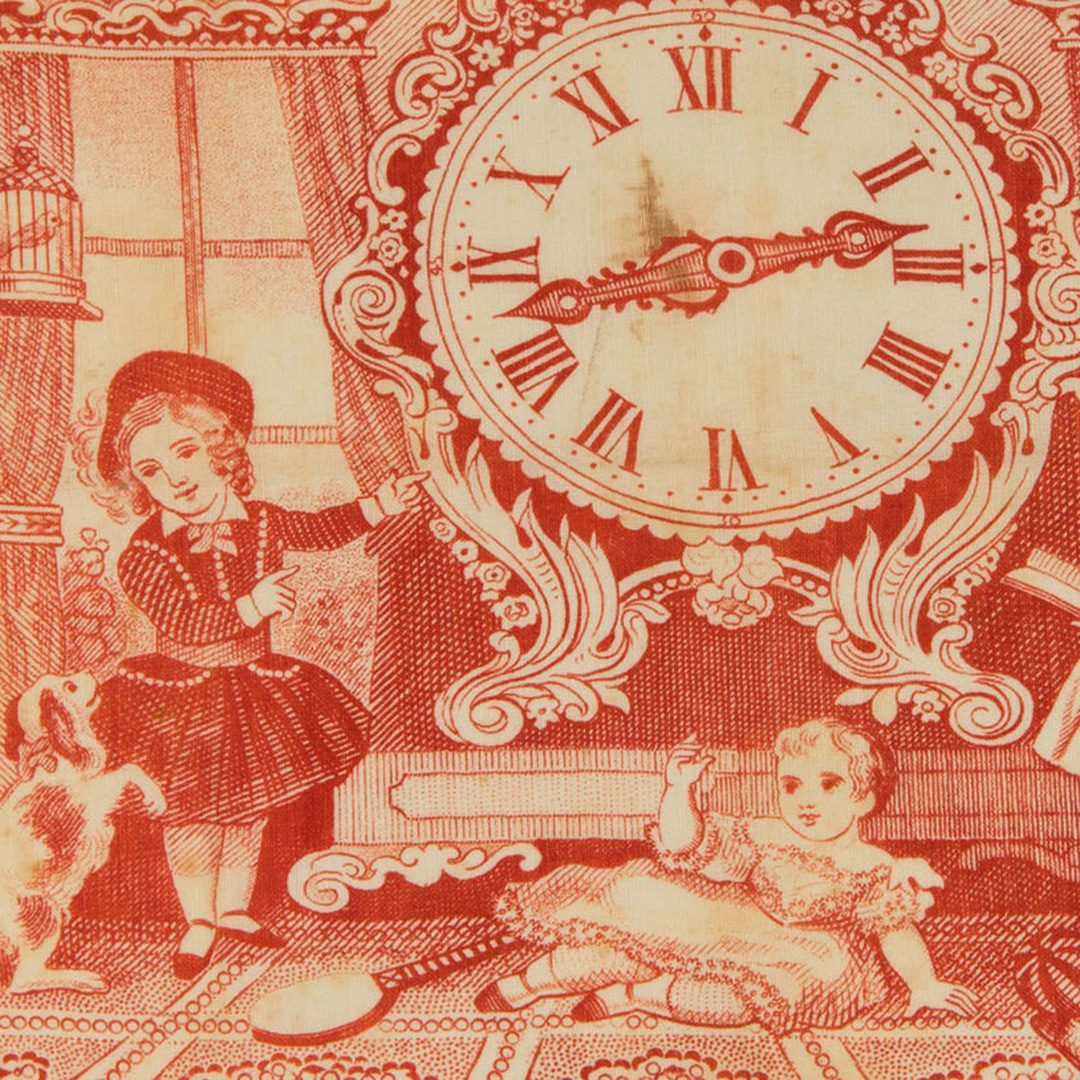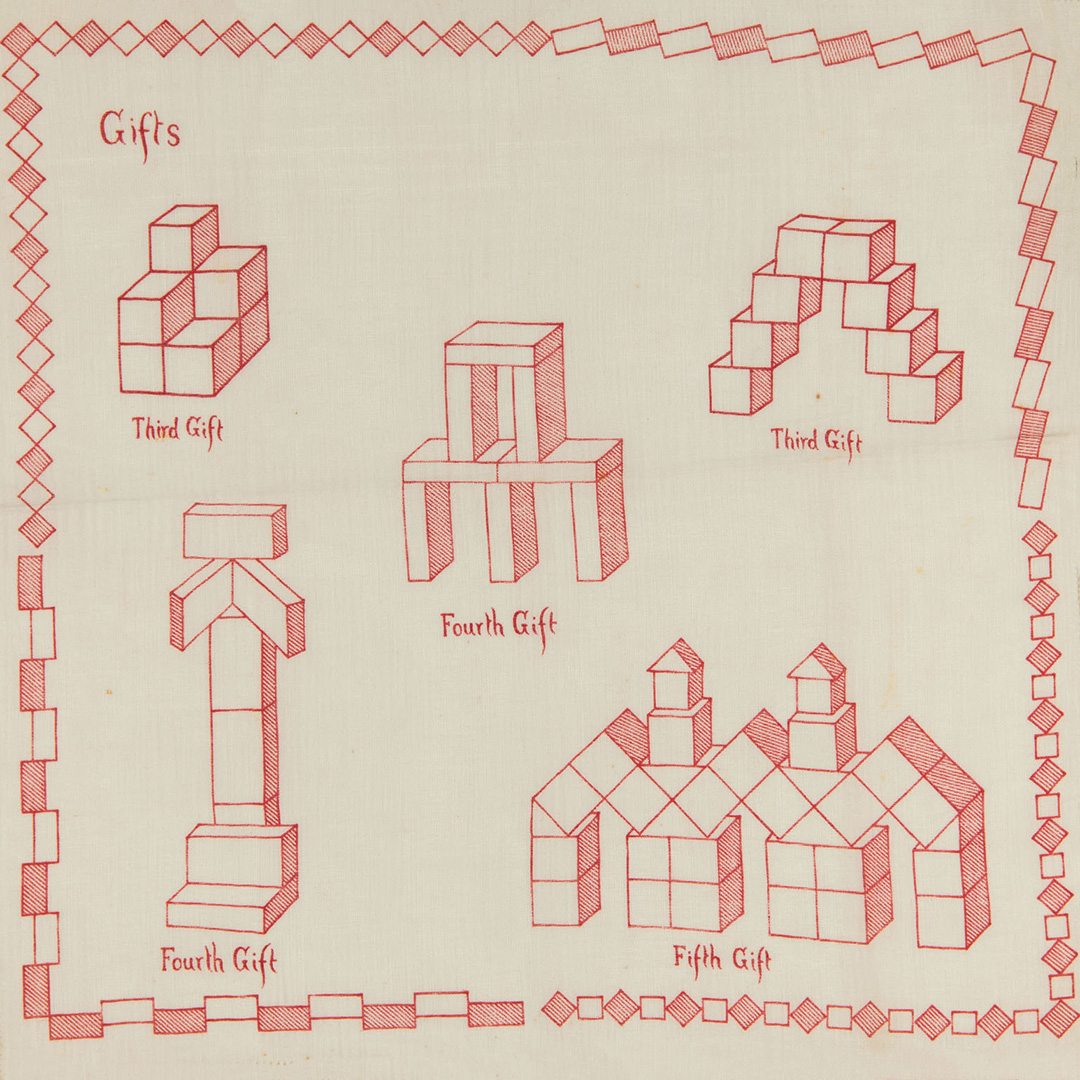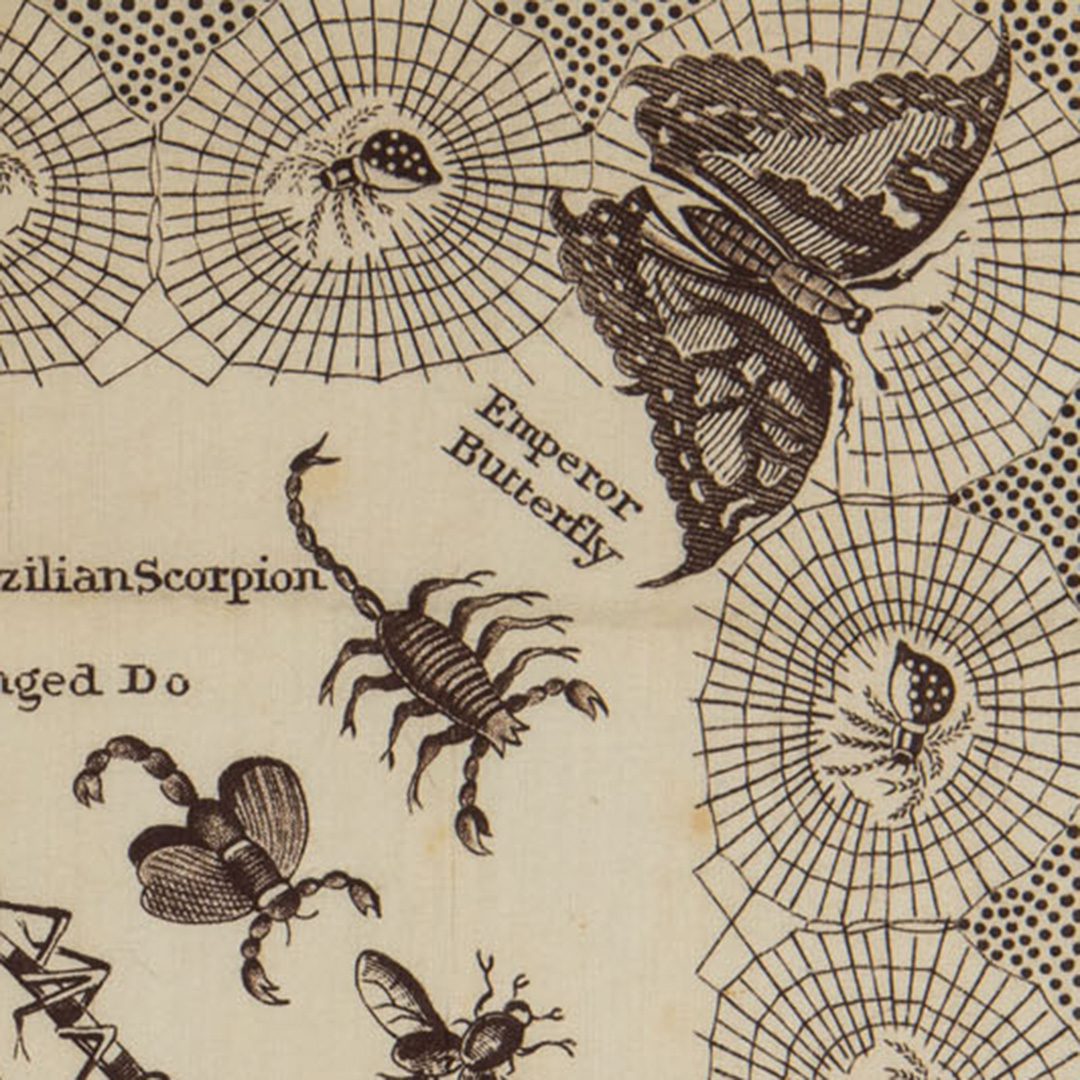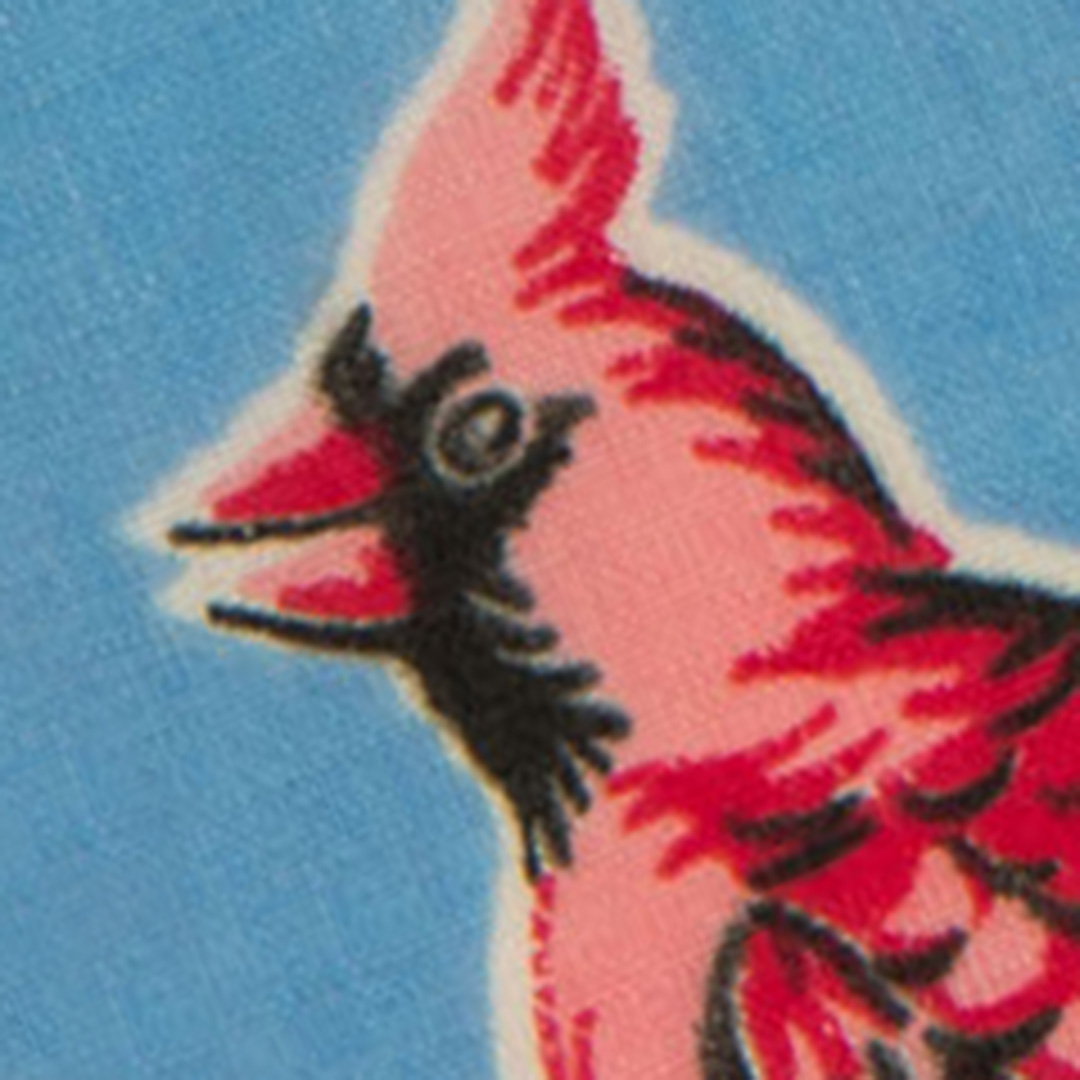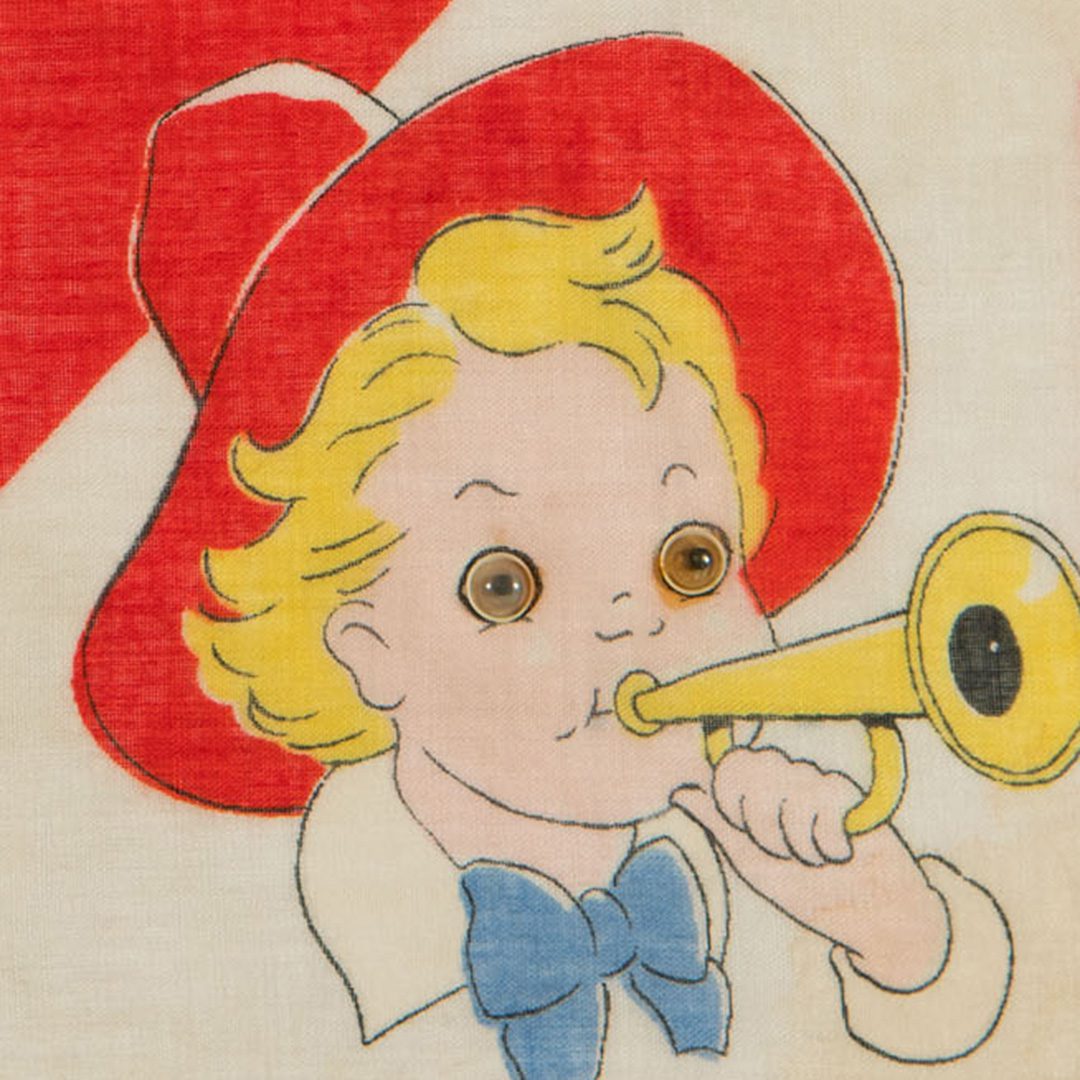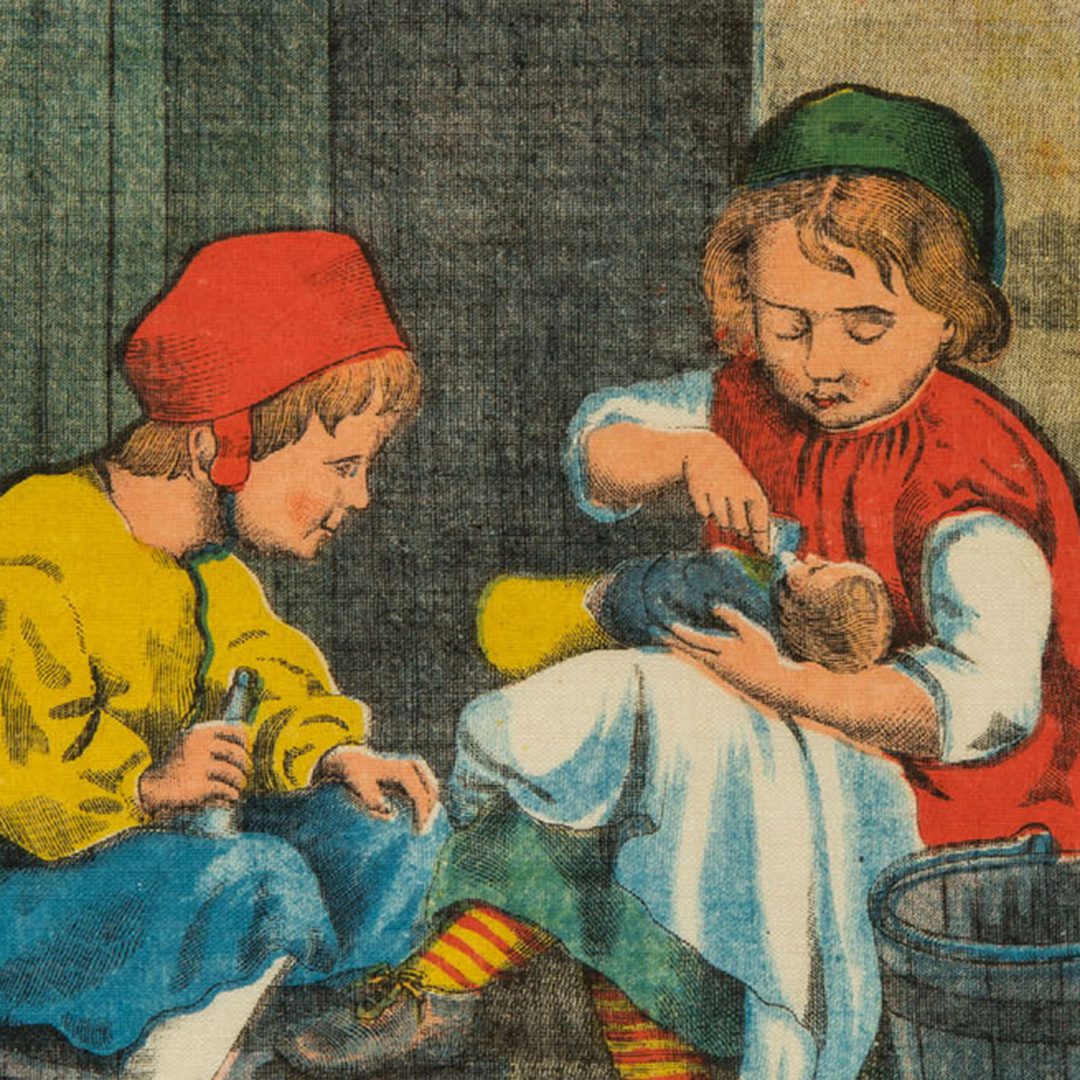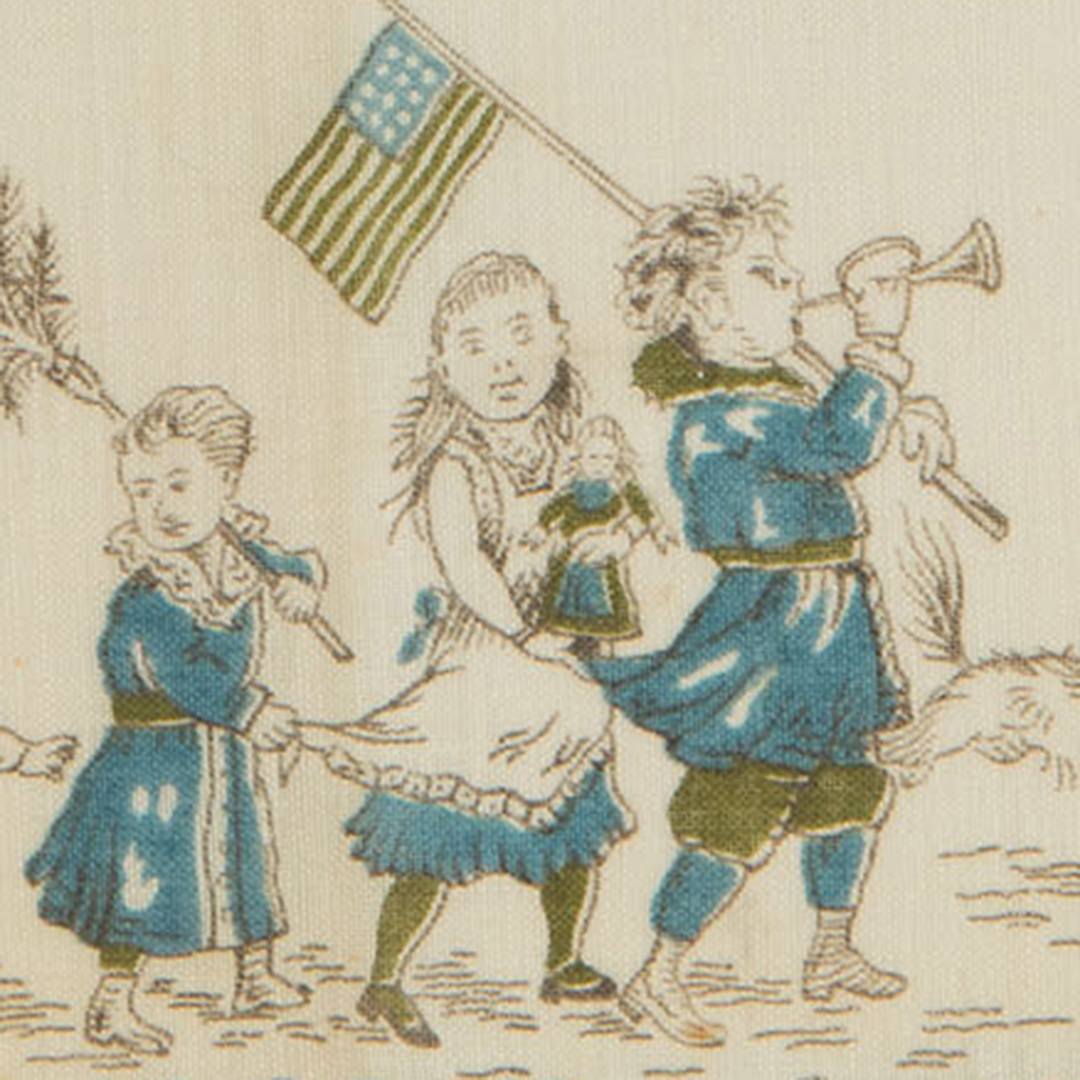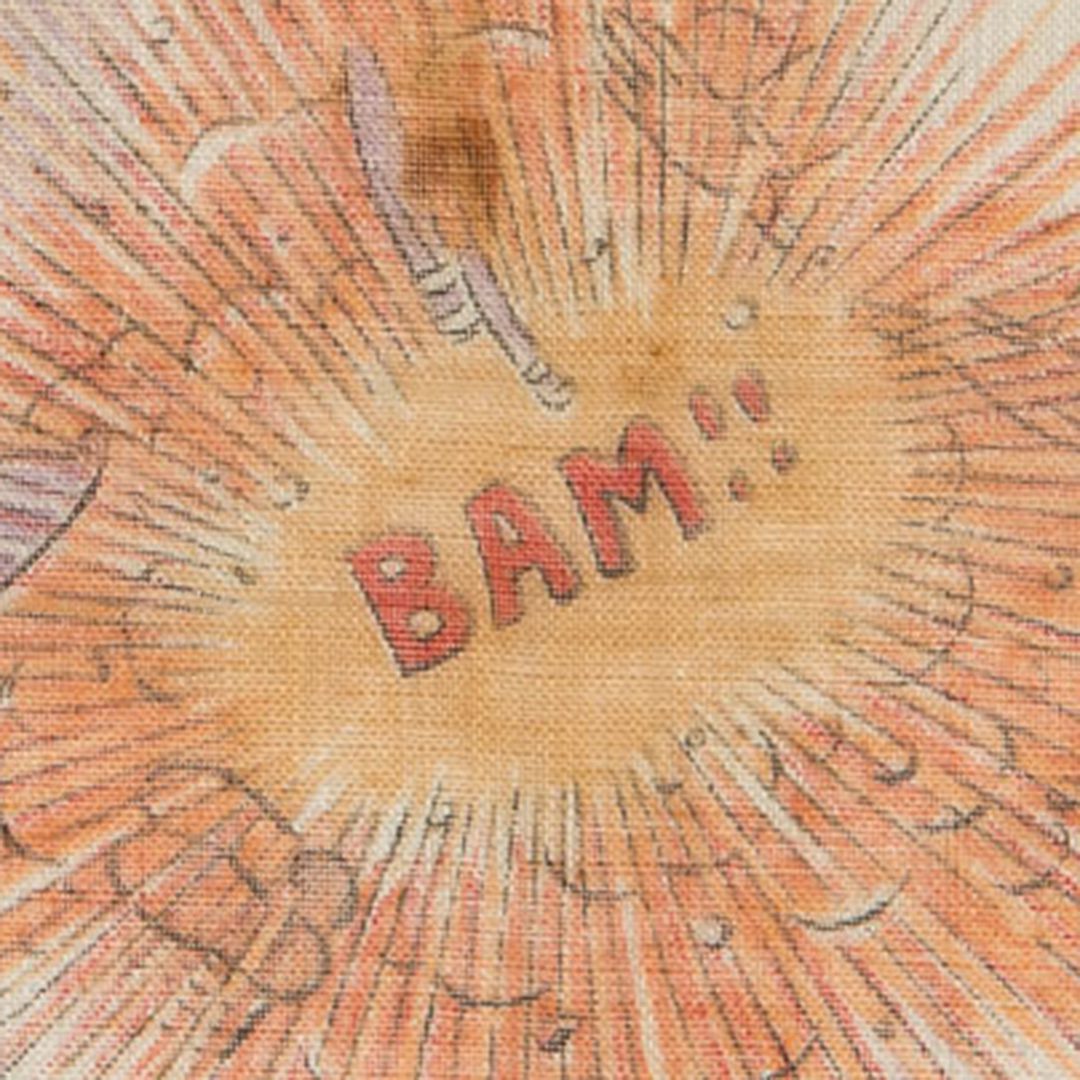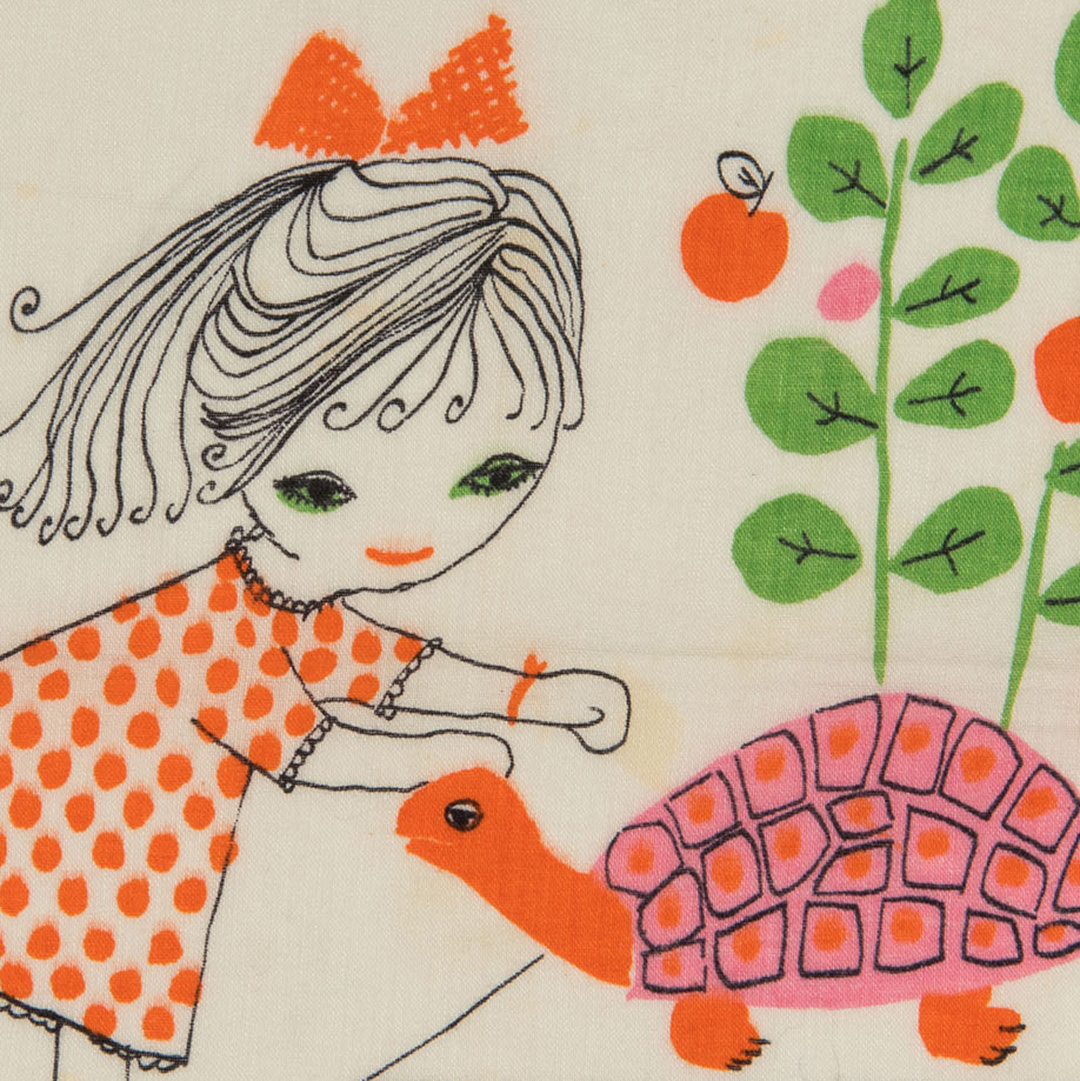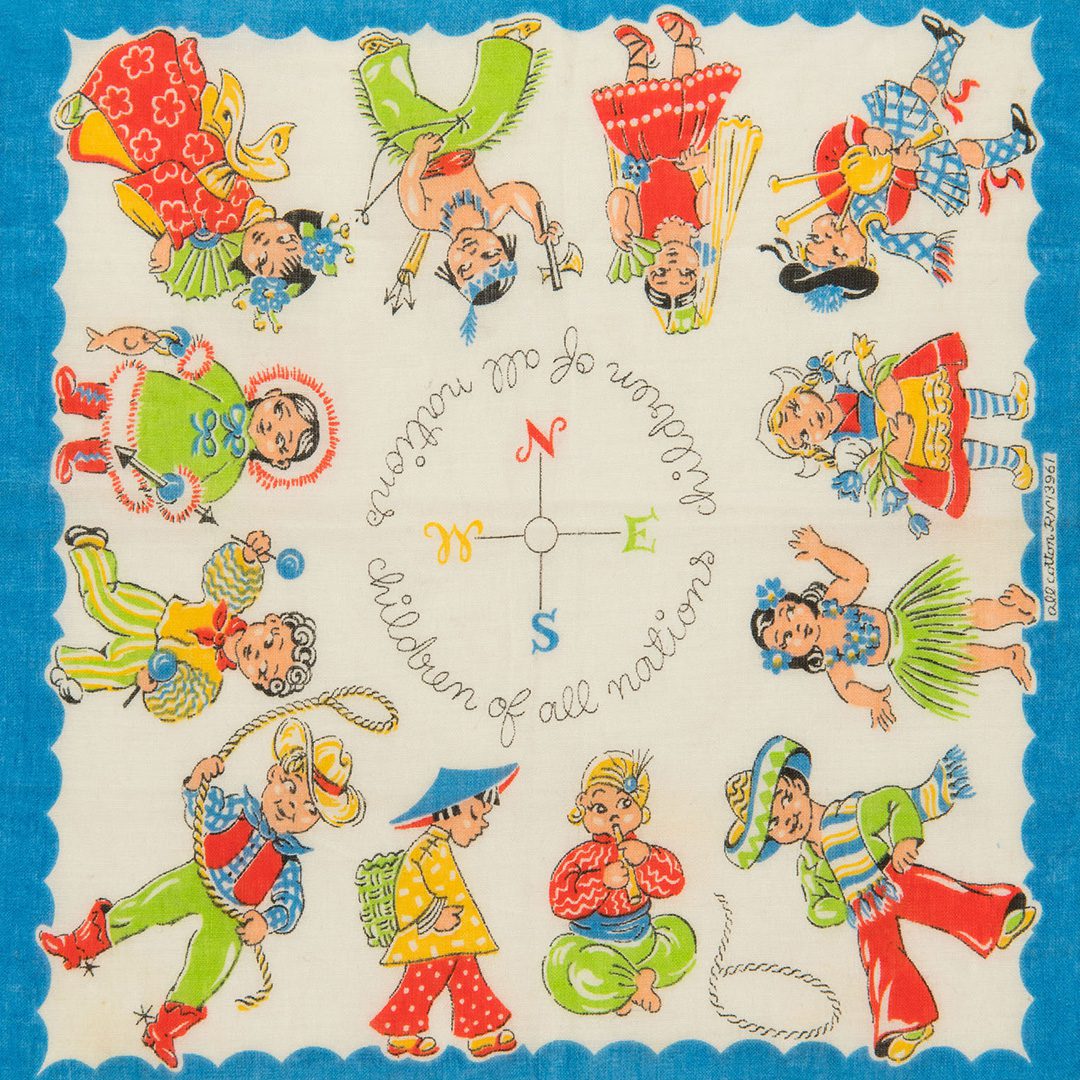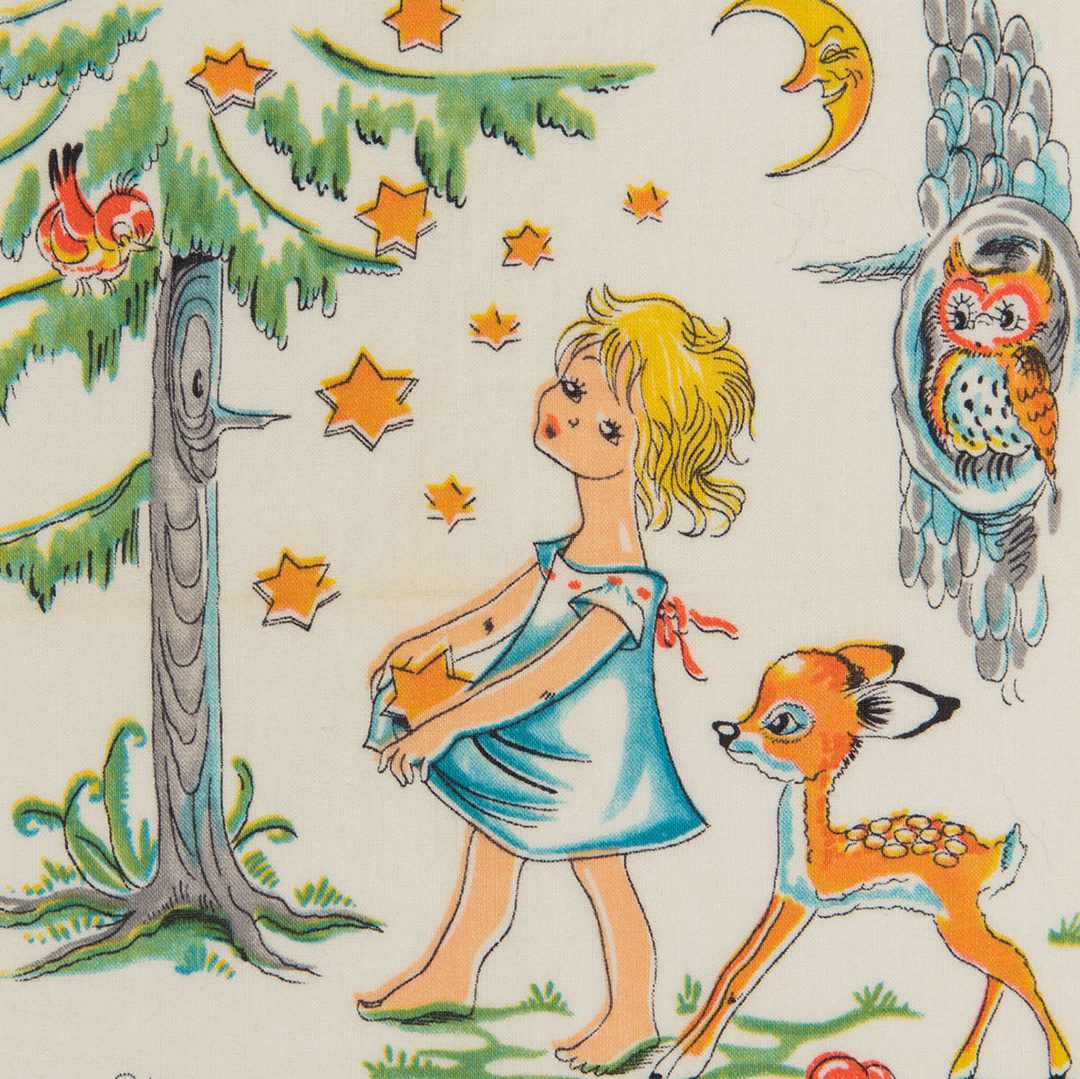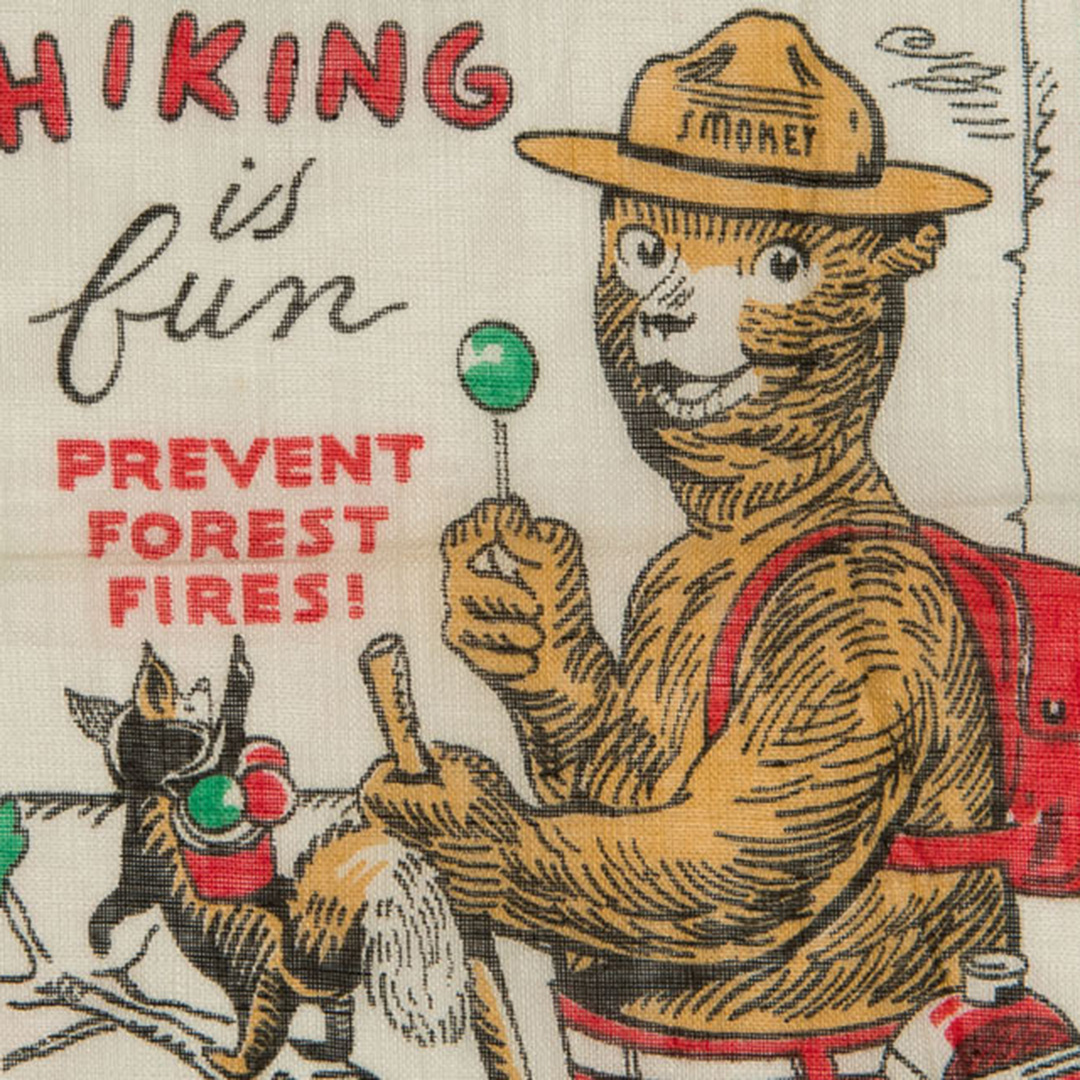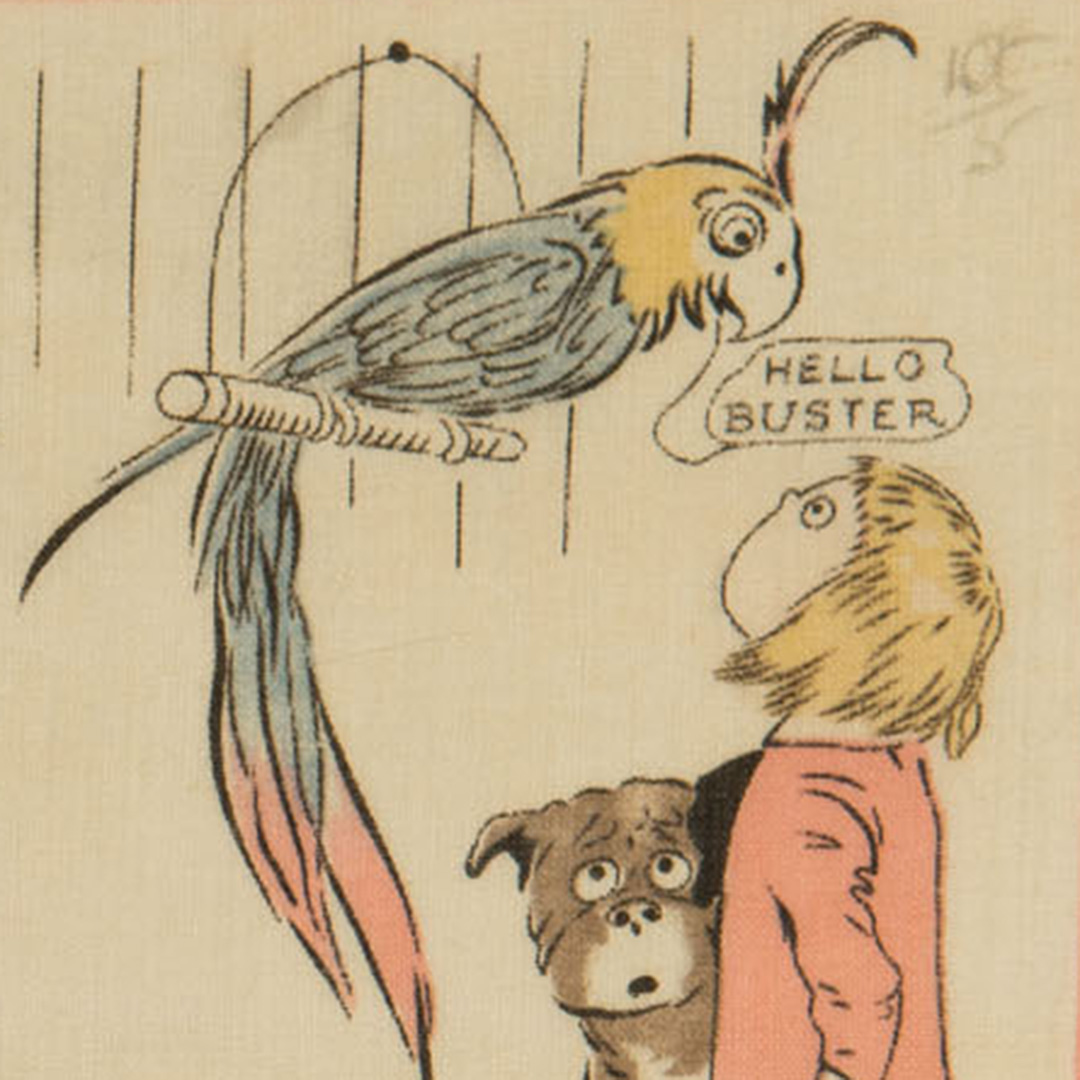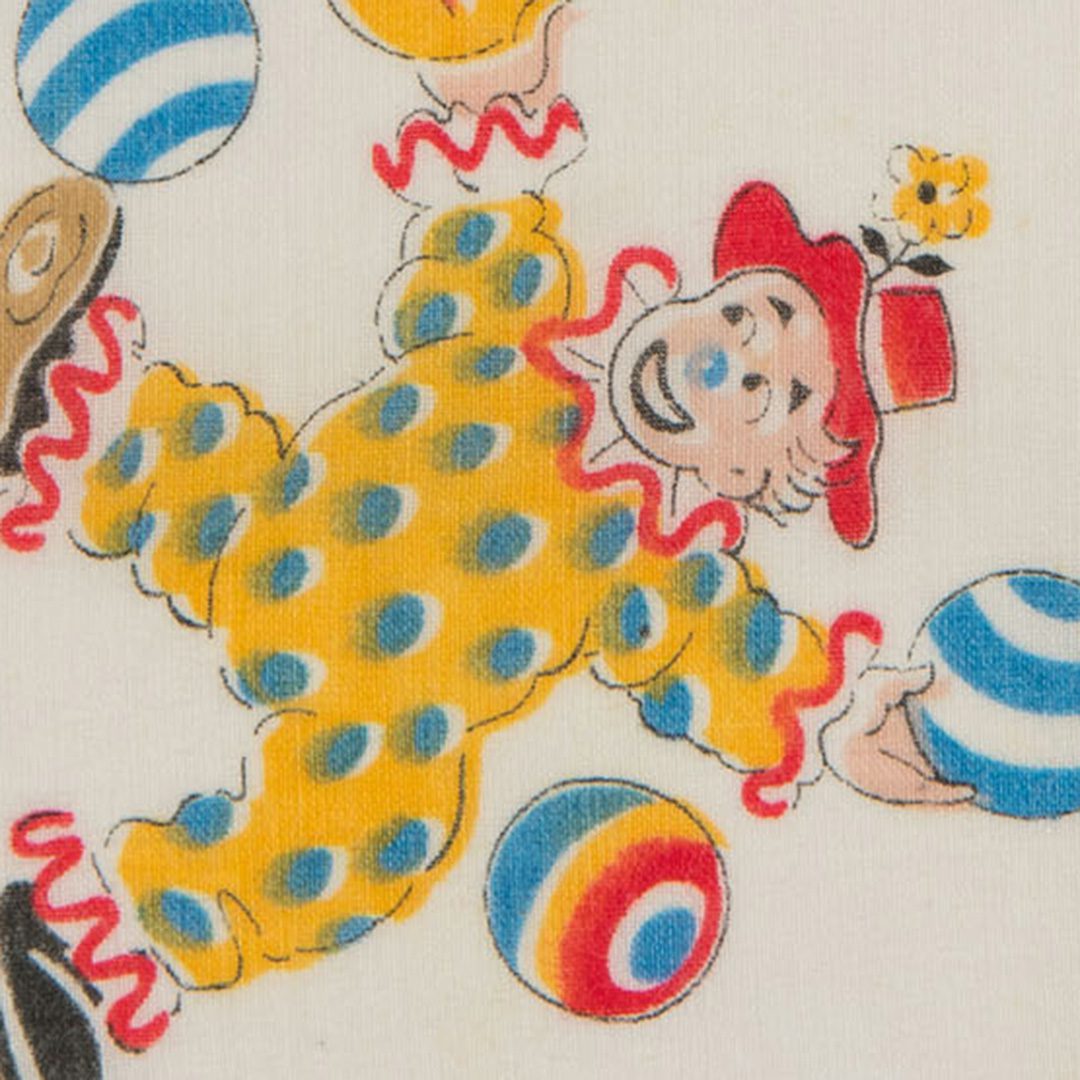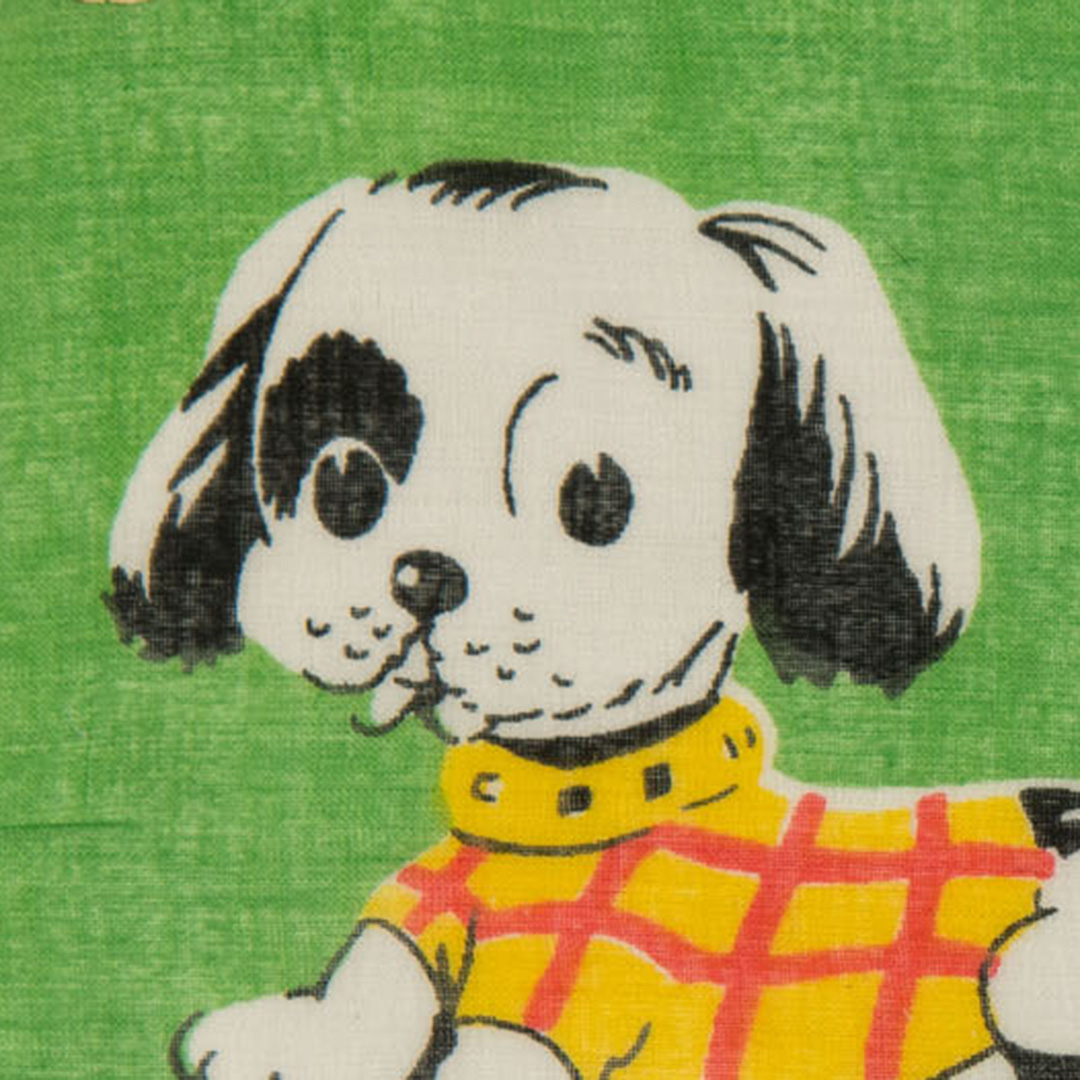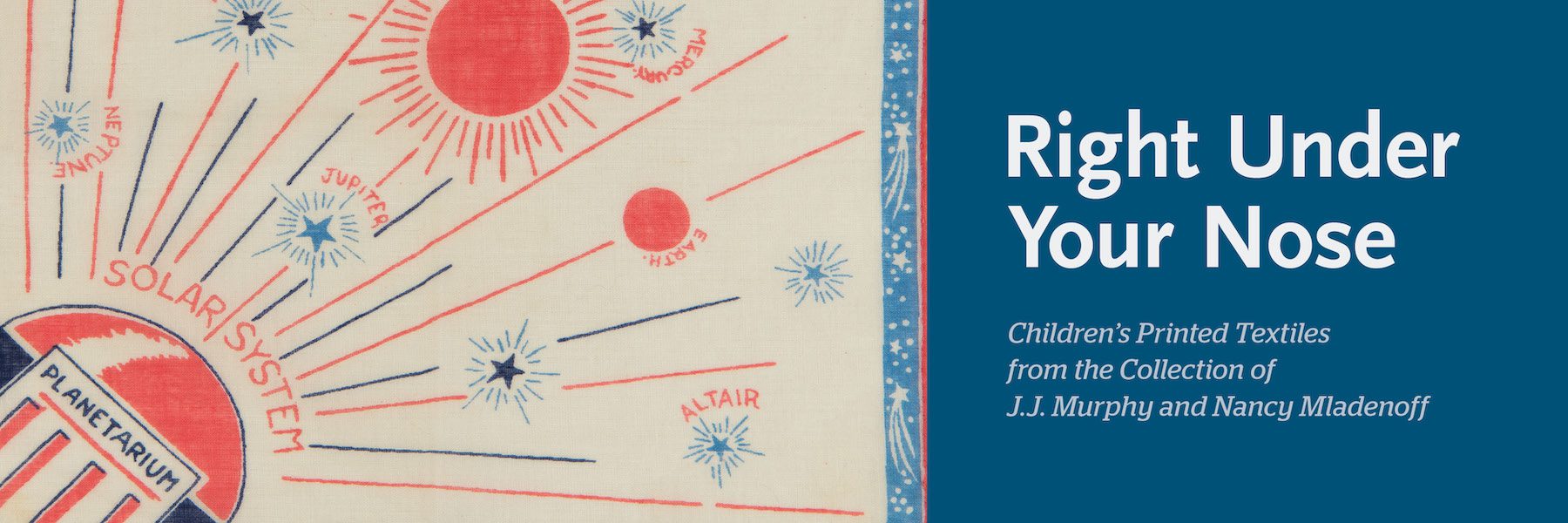
What do insects, alphabets, circus clowns, shadow puppets, the solar system, and a lumberjack beaver all have in common?
These are all themes featured on printed cotton handkerchiefs manufactured for children and adolescents between the 18th and 20th centuries. Usually carried close to the user’s body, these intimate, everyday objects taught lessons, instilled predominant social and cultural standards, and sometimes even inspired a giggle or happy memory while providing soothing relief for a runny nose. Close examination of these objects reveals technological innovations in manufacturing, shifts in understandings of children and the idea of childhood, the development of ideas like nationalism and cultural identity, the evolution of gender norms and racial stereotypes, and more.
Featuring 21 selections from the collection of J.J. Murphy and Nancy Mladenoff, Right Under Your Nose is inspired by Murphy and Mladenoff’s compendium of more than 3,200 examples of children’s printed textiles, gifted to Shelburne Museum in 2020. This digital resource is a sneak peek to a bricks-and-mortar exhibition featuring dozens of examples of children’s handkerchiefs and associated ephemera in the Dana-Spencer Hat & Fragrance Textile Galleries from May 13 to October 21, 2023.

Unidentified designer and manufacturer (English)
The Nursery Clock Child's Handkerchief, ca. 1840
Printed cotton, 12 1/4 x 14 1/4 in.
Gift of Nancy Mladenoff and J.J. Murphy, 2020-9.2509
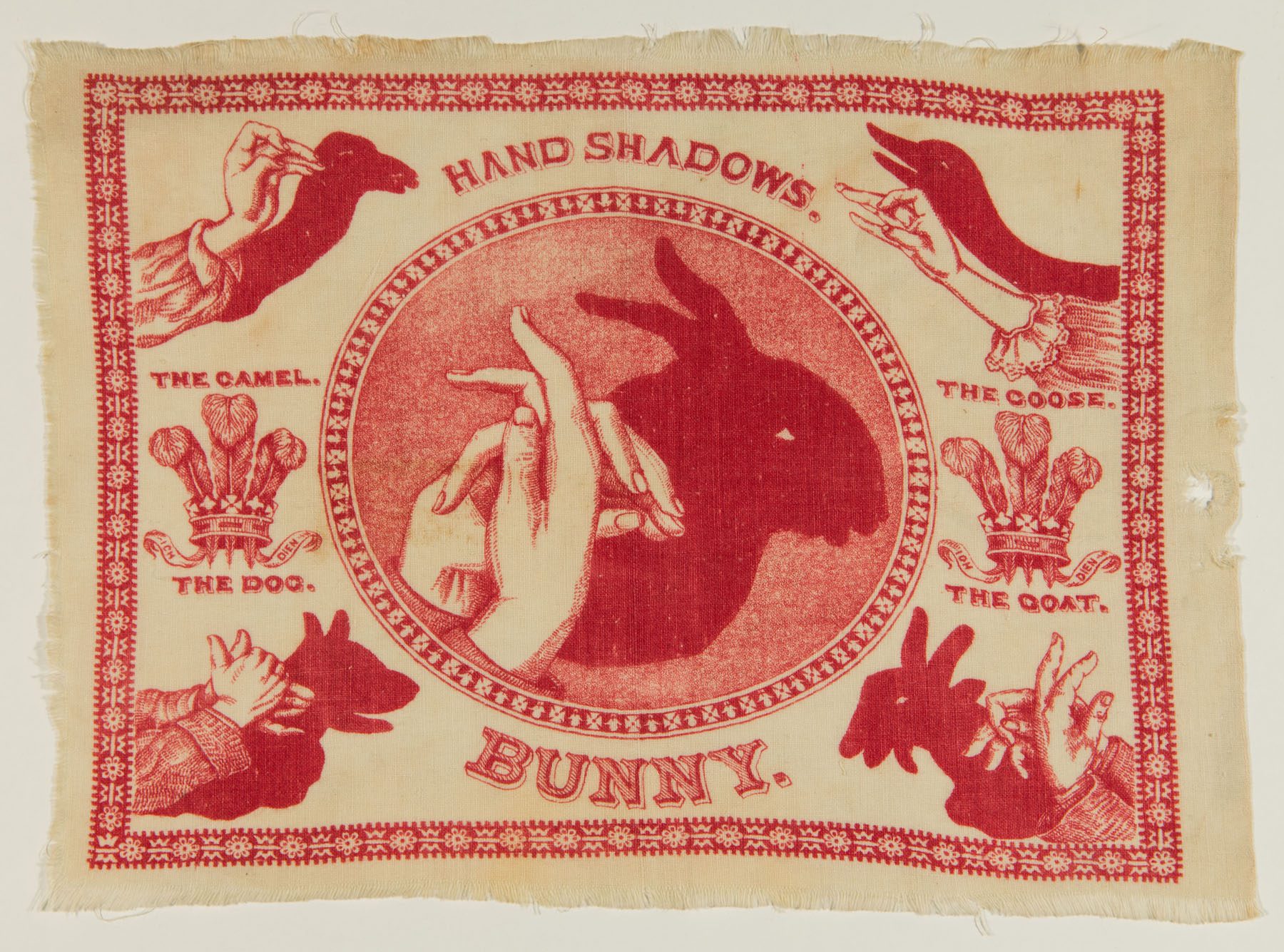
Unidentified designer and manufacturer (probably English) Hand Shadows Child's Handkerchief, ca. 1870 Printed cotton, 8 x 11 in. Gift of Nancy Mladenoff and J.J. Murphy, 2020-9.2440

Unidentified designer and manufacturer (American)
Kindergarten Gifts Child's Handkerchief, ca. 1900–15
Printed cotton, 11 1/2 x 11 7/8 in.
Gift of Nancy Mladenoff and J.J. Murphy, 2020-9.2271
The idea of “Kindergarten” was first conceptualized by the German educator Friedrich Froebel (1782–1852) in 1837. In Froebel’s estimation, children best learned through creative, open-ended play with toys that proceed from simple to more complex, like soft balls and wooden blocks shaped like cylinders, spheres, and cubes. Known as “Froebel’s Gifts,” these toys were meant to encourage exploration and imagination, develop skills like manual dexterity and coordination, and allow children to investigate foundational aspects of disciplines like mathematics, science, engineering, and architecture. Froebel’s methodologies continue to be used today in early childhood education and are credited as inspiration for modernist architects like Frank Lloyd Wright (1867–1959), Le Corbusier (1887–1965), and Buckminster Fuller (1985–1983) as well as the Bauhaus.
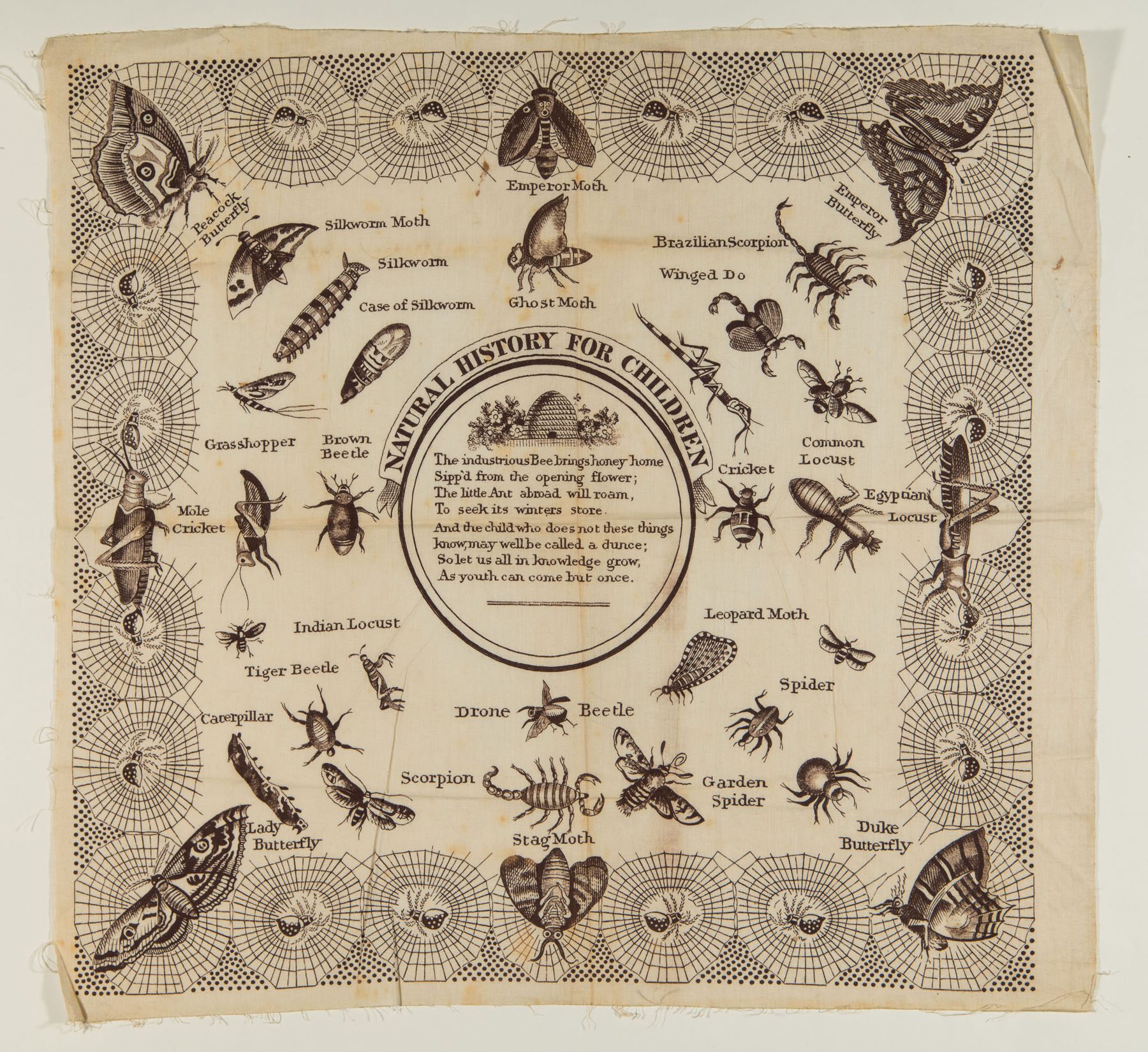
Unidentified designer and manufacturer
Natural History for Children Child's Handkerchief, date unknown
Printed cotton, 14 3/4 x 15 1/2 in.
Gift of Nancy Mladenoff and J.J. Murphy, 2020-9.2683
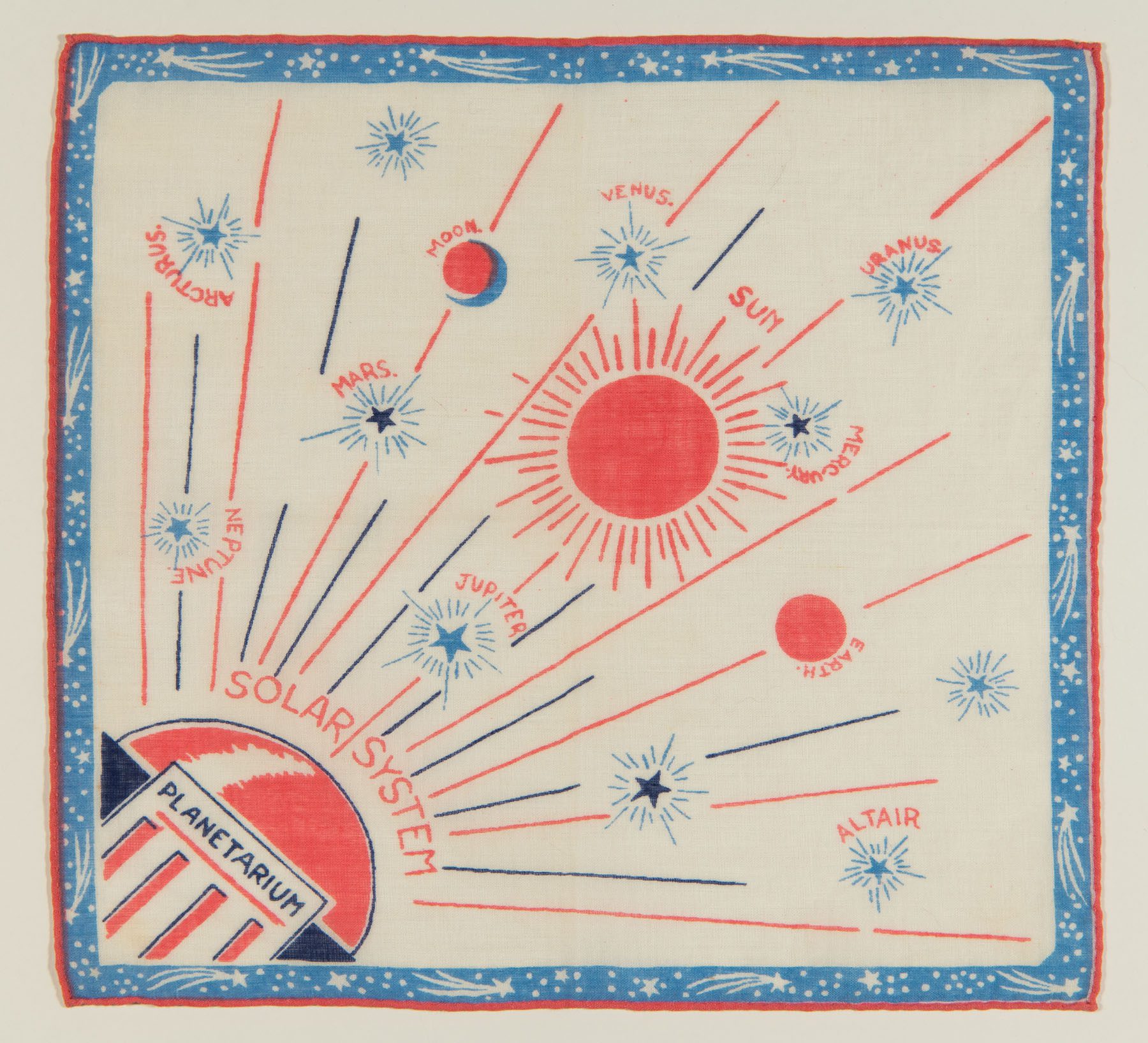
Unidentified designer and manufacturer
Solar System Child's Handkerchief, date unknown
Printed cotton, 9 x 8 1/2 in.
Gift of Nancy Mladenoff and J.J. Murphy, 2020-9.2751
Illustrations of flora, fauna, and the natural world often decorated handkerchiefs aimed at young audiences. At first glance this graphic of the solar system appears to be missing Saturn, the seventh planet from the sun. The image also includes two of the brightest stars in the northern hemisphere sky: Arcturus and Altair.
Rather than a complete list of the known plants and stars, this illustration imparts what someone might see when viewing a portion of the night sky at a moment in time or at a planetarium. Sometimes called sky theaters, planetariums use special projectors to create simulations of the night sky on a domed ceiling. These buildings became especially popular during the 1950s and 60s when the so-called “Space Race” inspired the construction of more than 1,200 planetariums in American high schools.
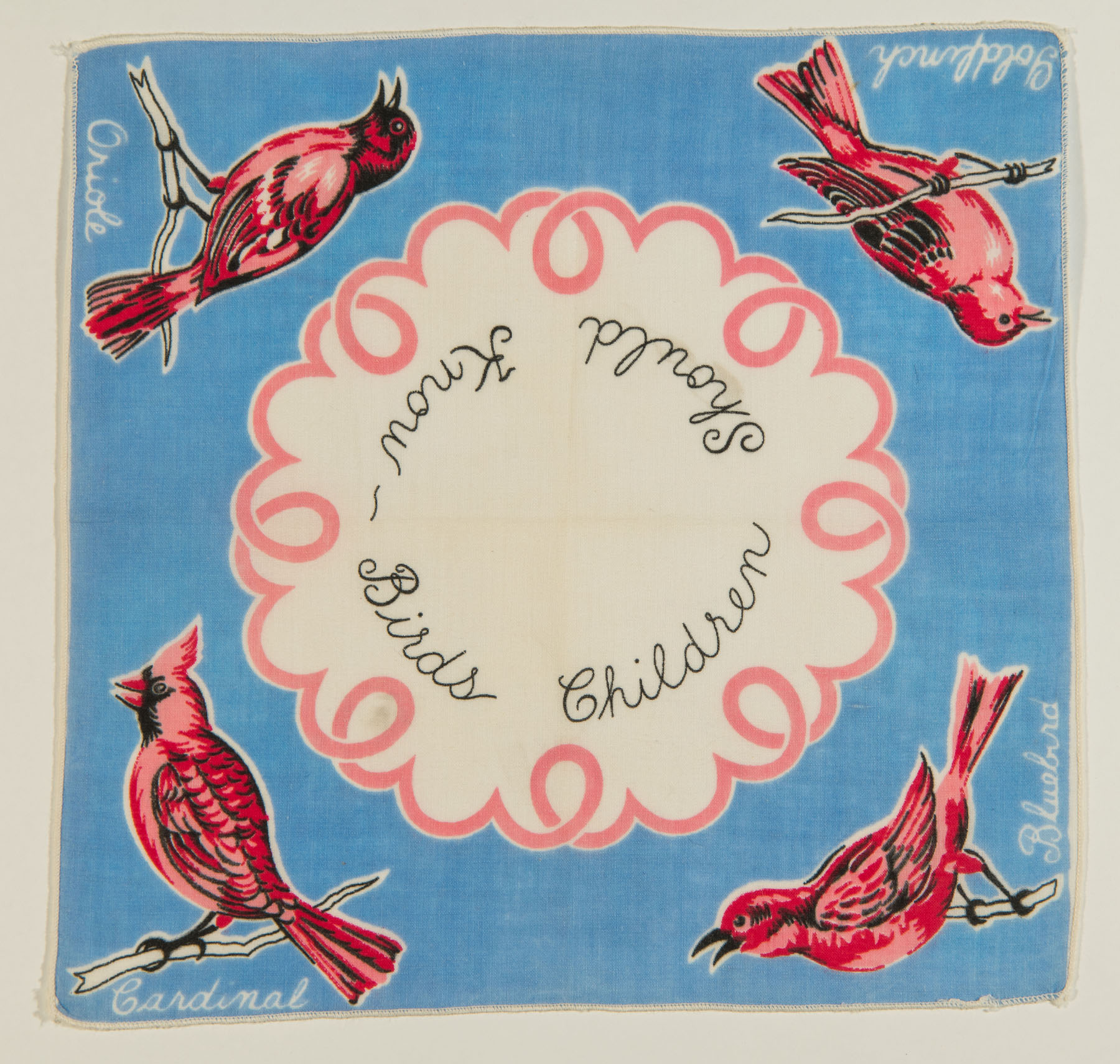
Unidentified designer and manufacturer
Children Should Know Birds Child's Handkerchief, date unknown
Printed cotton, 8 1/2 x 9 in.
Gift of Nancy Mladenoff and J.J. Murphy, 2020-9.290
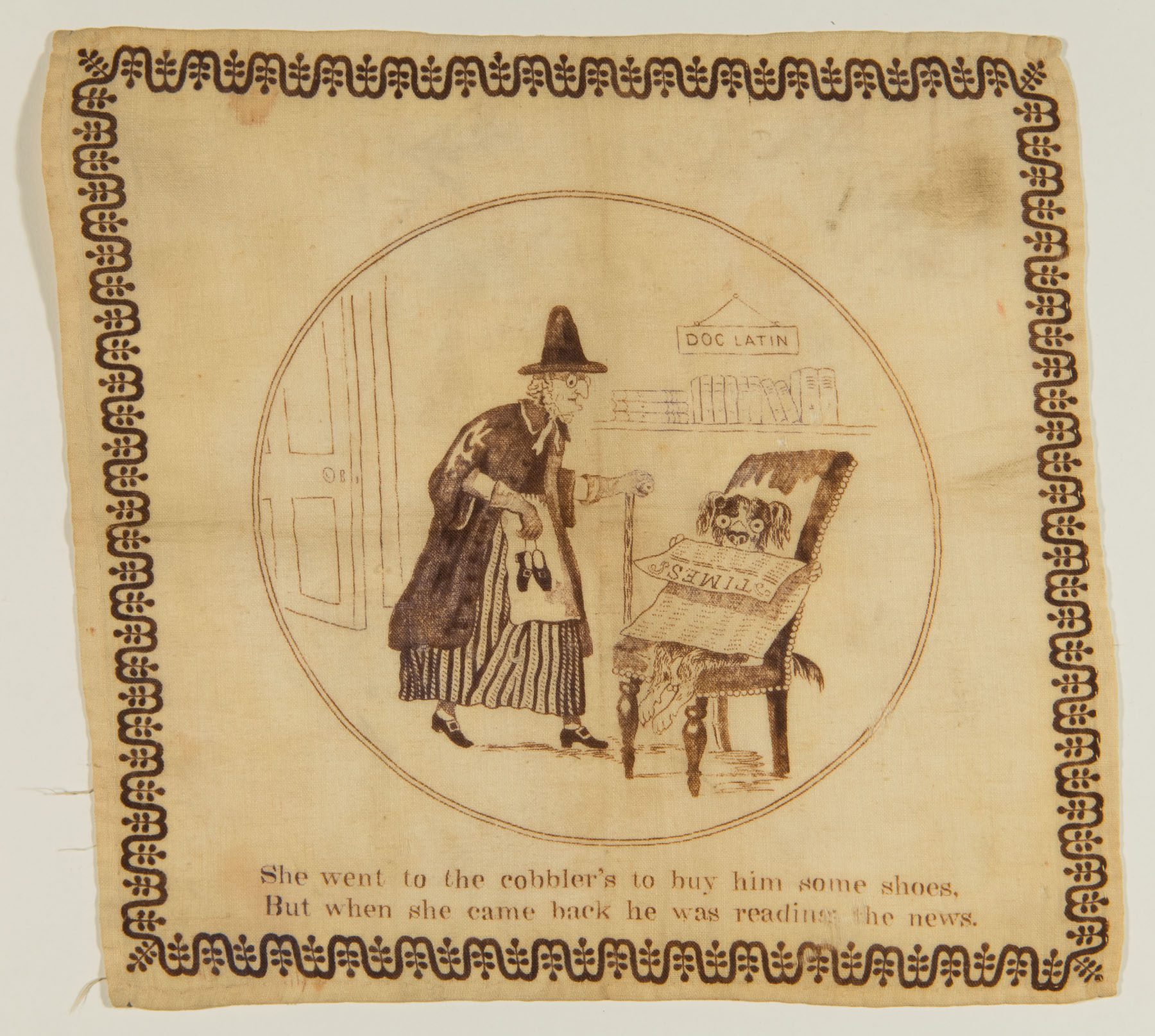
Unidentified designer and manufacturer (probably American)
Mother Hubbard Child's Handkerchief, late 19th century
Printed cotton, 8 x 8 1/4 in.
Gift of Nancy Mladenoff and J.J. Murphy, 2020-9.2452
Handkerchiefs made for children often included snippets of popular nursery rhymes like Mary, Mary, Quite Contrary, Little Boy Blue, and Old Mother Hubbard. The precise origins of these stories likely stem from oral traditions, but the first published version of The Comic Adventures of Old Mother Hubbard and her Dog was printed in 1805 and attributed to Sarah Catherine Martin (1768–1826). While the rhyme’s verses vary according to tradition, they describe an elderly woman who lives with a dog who has a colorful sense of humor. The dog engages in various shenanigans including smoking a pipe, standing on its head, playing the flute, riding a goat, feeding a cat, dancing a jig, and more. This handkerchief depicts Old Mother Hubbard returning from the cobbler to find her dog reading the news, and was likely part of a series of hankies printed with assorted verses from the story. A shelf of books with a hanging sign reading “Dog Latin” humorously reveals that the mutt has been studying up on the language arts.
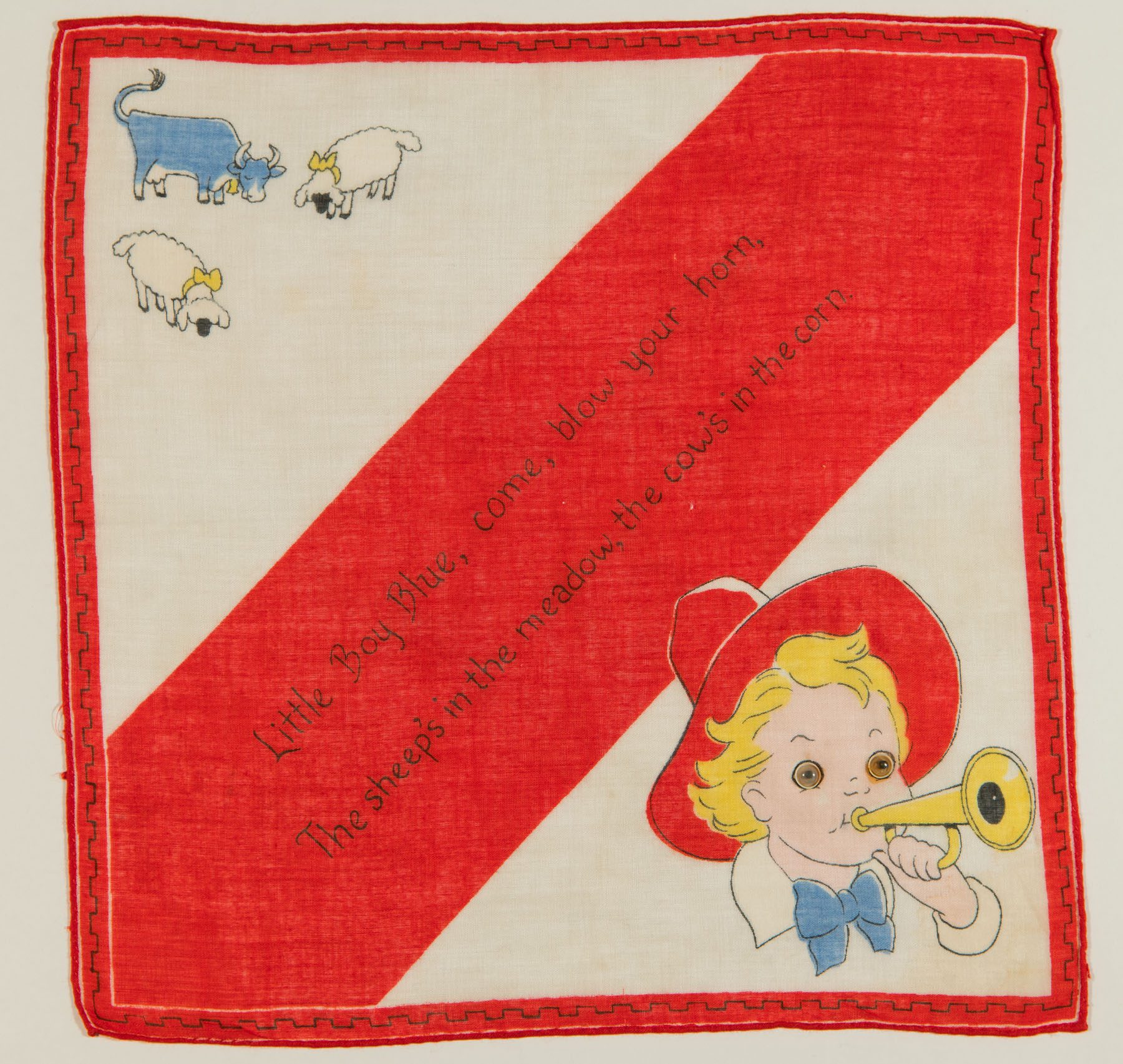
Unidentified designer and manufacturer
Little Boy Blue Child's Handkerchief, date unknown
Printed cotton, 10 x 9 7/8 in.
Gift of Nancy Mladenoff and J.J. Murphy, 2020-9.245

Designed by Gladys Peto (English, 1890–1977)
Unidentified manufacturer (English)
Mary, Mary Quite Contrary Child's Handkerchief, ca. 1920's & 1930's
Printed cotton, 9 1/4 x 9 3/8 in.
Gift of Nancy Mladenoff and J.J. Murphy, 2020-9.1310
By kind permission of her niece Helen Richardson
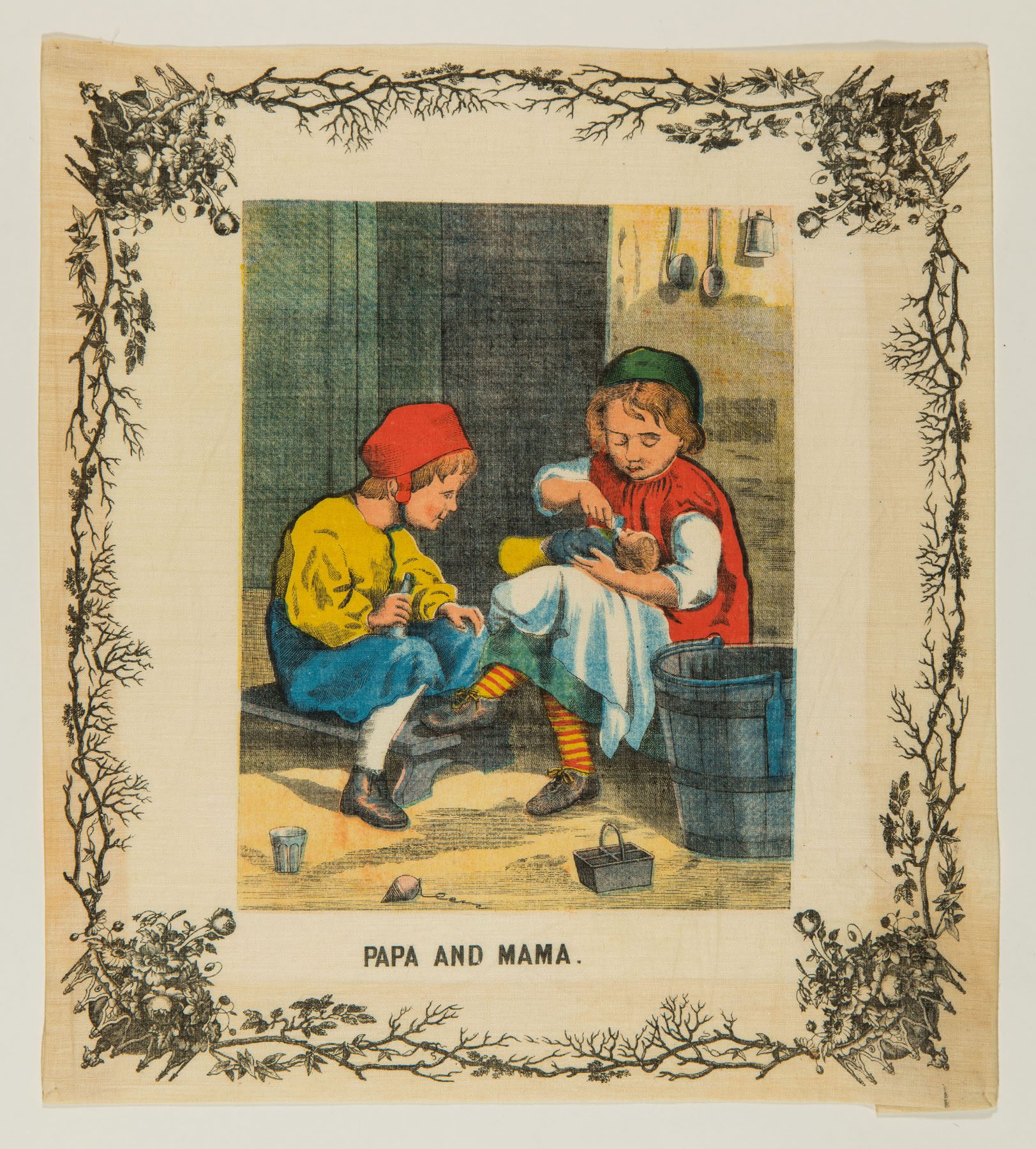
Unidentified designer and manufacturer (American)
Papa and Mama Child's Handkerchief, ca. 1880
Printed chromolithograph cotton, 11 3/4 x 10 1/2 in.
Gift of Nancy Mladenoff and J.J. Murphy, 2020-9.2447
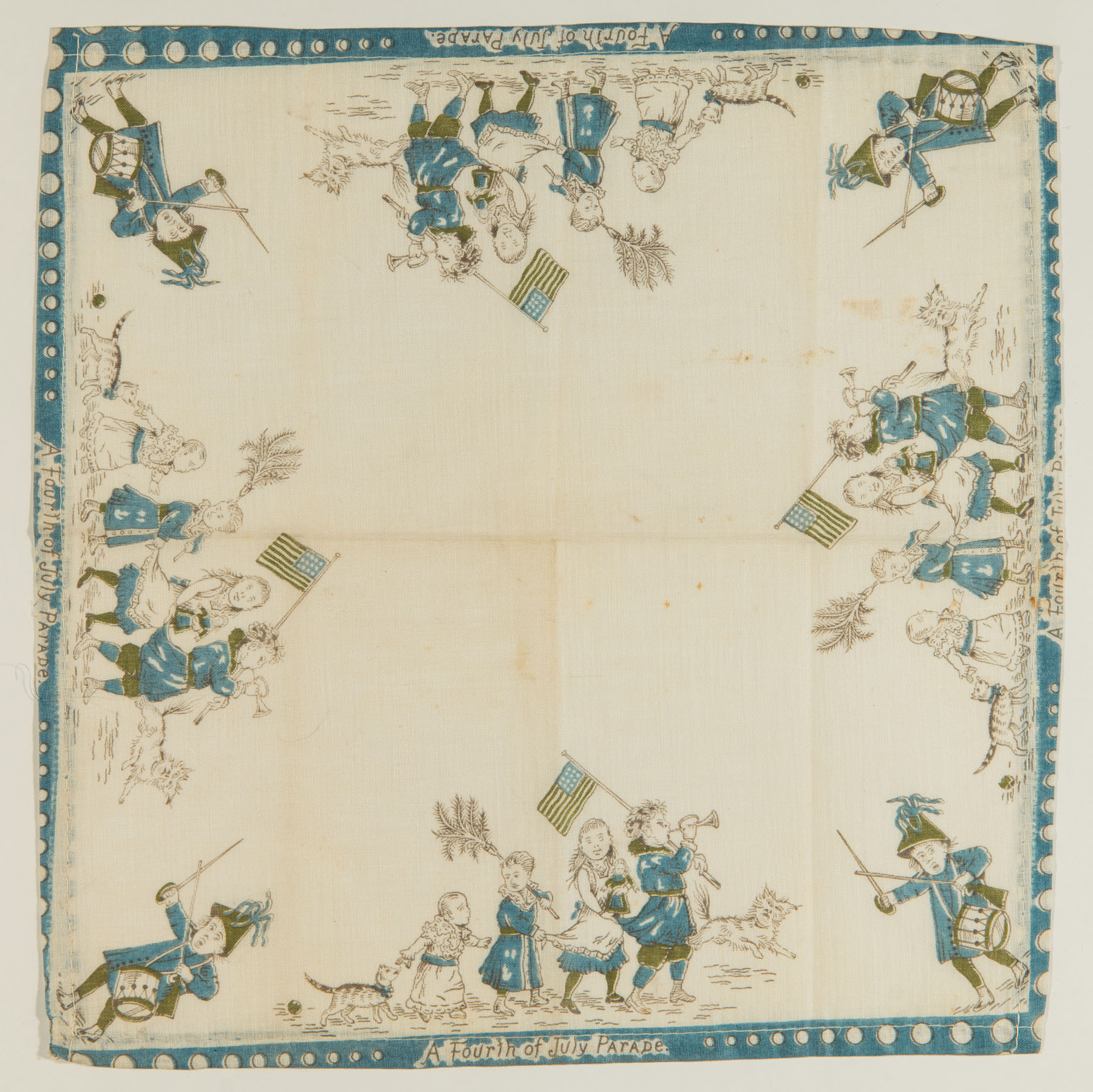
Unidentified designer and manufacturer (American)
A Fourth of July Parade Child's Handkerchief, date unknown
Printed cotton, 11 3/8 x 11 1/2 in.
Gift of Nancy Mladenoff and J.J. Murphy, 2020-9.2299

Designed by Harry Conway "Bud" Fisher (American, 1885–1954)
Unidentified manufacturer (American)
Mutt and Jeff, At the Front Child's Handkerchief, ca. 1920
Printed cotton, 9 5/8 x 9 1/2 in.
Gift of Nancy Mladenoff and J.J. Murphy, 2020-9.1017
MUTT & JEFF © Pierre S De Beaumont. Reprinted with permission of ANDREW MCMEEL SYNDICATION. All rights reserved.
The development of widely available audio and print media like radio, books, magazine, newspapers, and comics had a sizable influence on the production of handkerchiefs in the early 20th century. Popular characters like Little Orphan Annie, Mickey Mouse, Buster Brown, Smokey the Bear, and more connected children and adolescent consumers to American visual culture and mass media.
Launched in 1907, the comic strip Mutt and Jeff inspired at least four different handkerchief designs including “A Happy New Year,” “Aero Postman,” and this design, “At the Front.” Here, our protagonists remark that they would like to be sent to the front lines of World War I to fight “Fritz,” a nickname assigned by Allied soldiers to German combatants. While Mutt and Jeff end up buried beneath a pile of blasted rubble, the message conveyed—that of anti-German, nationalistic sentiment—cannot be missed.

Designed by Marie-Laure (French)
Unidentified manufacturer
Julie et sa tortue Caroline Child's Handkerchief, date unknown
Printed cotton, 8 5/8 x 7 3/4 in.
Gift of Nancy Mladenoff and J.J. Murphy, 2020-9.1306
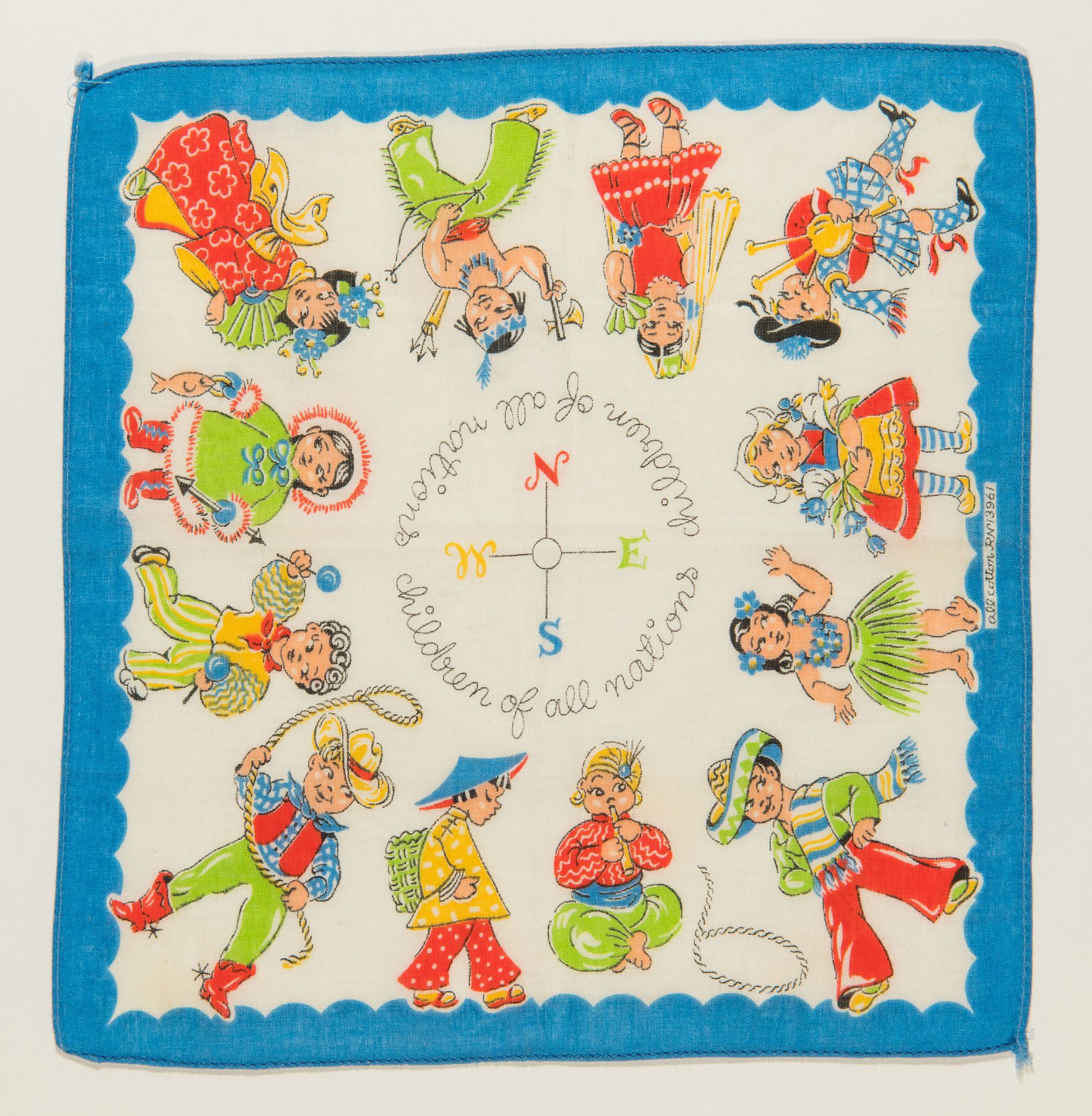
Unidentified designer and manufacturer (American)
Children of All Nations Child's Handkerchief, 20th century
Printed cotton, 8 3/4 x 9 in.
Gift of Nancy Mladenoff and J.J. Murphy, 2020-9.120
In addition to reading, writing, and arithmetic, handkerchiefs sometimes exposed their users to other cultures and languages. This design includes children wearing clothes that might be associated with “traditional” outfits from Asia, Europe, and North America. While the impetus behind the development of images like this one may have been to foster cross-cultural understanding, the costumed figures are in fact generalized caricatures of ethnic “types.” Cultural historians remind us that “typing” is part of the larger process by which human beings assert, parcel out, and deny power to their communities. Through shorthand visual cues like the kimonos, grass skirts, bagpipes, or wooden clogs in this image, the makers and consumers of this handkerchief have distinguished themselves as different from the people represented in the image. While typing is often used as a way to parse and understand the world, its effects can be detrimental to the people and cultures who are designated as “others.”

Unidentified designer and manufacturer (German)
Many Golden Stars Fall Through the Night Child's Handkerchief, date unknown
Printed cotton, 9 x 9 in.
Gift of Nancy Mladenoff and J.J. Murphy, 2020-9.515
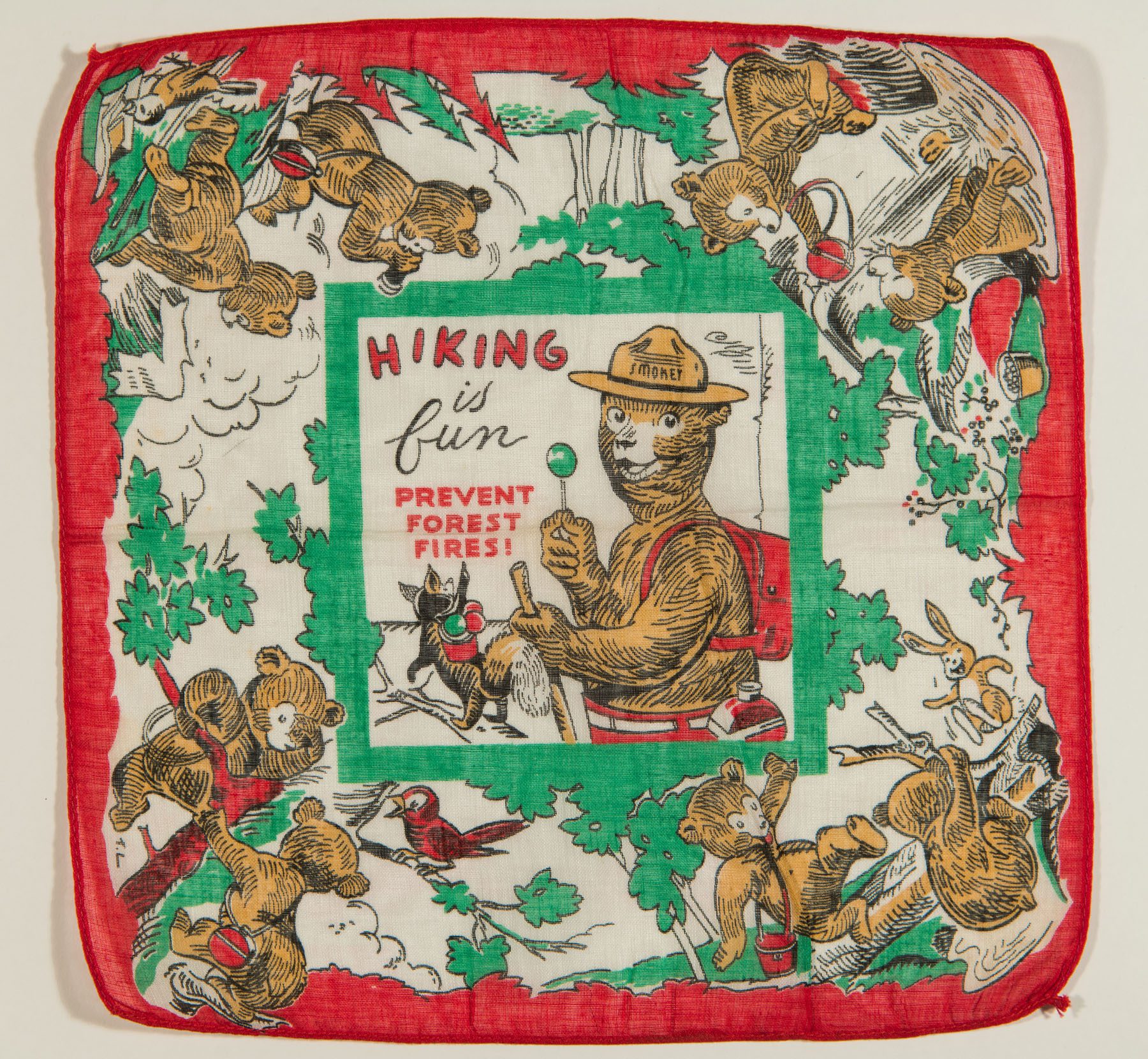
Designed by Thomas Babbitt Lamb (American, 1896–1988)
Unidentified manufacturer (American)
Hiking is Fun, Prevent Forest Fires! Child's Handkerchief, ca. 1940's
Printed cotton, 8 3/4 x 8 7/8 in.
Gift of Nancy Mladenoff and J.J. Murphy, 2020-9.380
© USDA Forest Service
© Tom Lamb

Designed by Robert F. Outcault (American, 1863–1928)
Unidentified manufacturer (American)
Buster Brown at the Zoo Child's Handkerchief, ca. 1905
Printed cotton, 12 3/4 x 12 3/4 in.
Gift of Nancy Mladenoff and J.J. Murphy, 2020-9.2467

Unidentified designer and manufacturer (American)
Circus Days Child's Handkerchief, 20th century
Printed cotton, 8 1/2 x 8 1/2 in.
Gift of Nancy Mladenoff and J.J. Murphy, 2020-9.542

Unidentified designer and manufacturer
Lumberjack Beaver Child's Handkerchief, date unknown
Printed cotton, 9 x 8 5/8 in.
Gift of Nancy Mladenoff and J.J. Murphy, 2020-9.634

Unidentified designer and manufacturer (American)
Cowboy and Cowgirl Child's Handkerchief, 20th century
Printed cotton, 9 5/8 x 9 5/8 in.
Gift of Nancy Mladenoff and J.J. Murphy, 2020-9.138
The mid-20th century saw a surge in the production of western subjects thanks to television stars like Hopalong Cassidy, Gene Autry, Roy Rogers, and Wild Bill Hickok. Unfortunately, these programs often valorized ideas like manifest destiny and westward expansion while condemning Indigenous peoples who fought to protect their way of life. Further, the narratives in these programs were usually egregiously sexist, commonly placing the intelligence and status of female characters beneath that of the male hero and his horse. While this handkerchief features two cowboys on their trusty steeds, the young female’s bow and arrow and braided hair recall caricatures of Native Americans. The image may be meant to convey a make-believe game of “Cowboys and Indians,” but the subtext of the composition reveals a gendered tension between settlers and Indigenous populations.
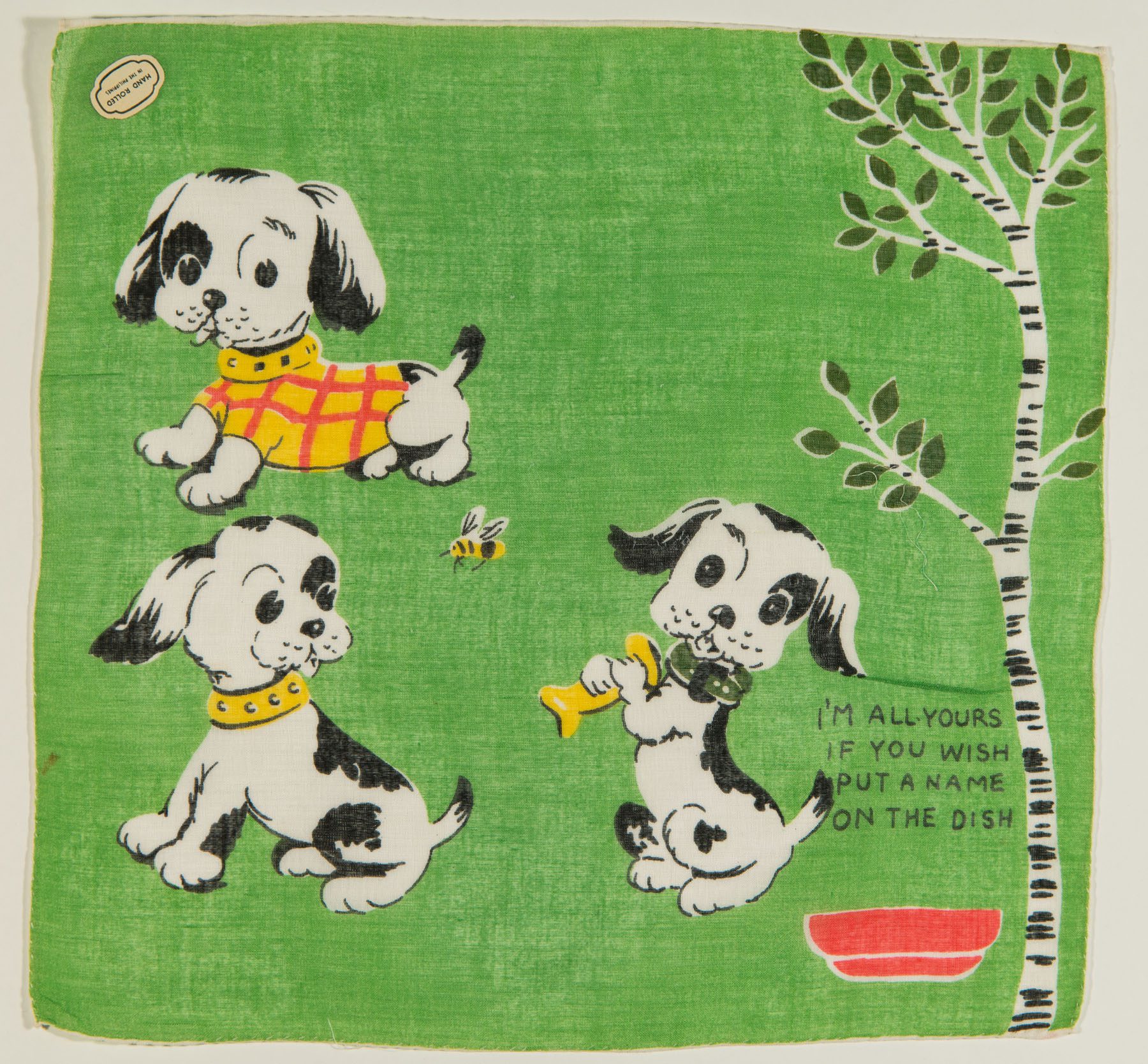
Unidentified designer (unknown), unidentified manufacturer (Philippines)
I'm All Yours If You Wish, Put a Name on the Dish Child's Handkerchief, date unknown
Printed cotton, 9 3/4 x 10 in.
Gift of Nancy Mladenoff and J.J. Murphy, 2020-9.885
